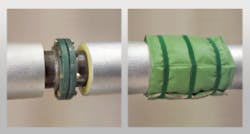Auburn Mfg Inc.: $20K and 100 Tons—The Five-Year Savings in One Small Mechanical Room
Bates College, located in Lewiston, ME, is regarded as one of the finest liberal arts colleges in the US. It is very concerned about its carbon emissions and has programs in place to reduce energy use and greenhouse gas emissions. When the opportunity arose to participate in a project to test a new insulation product designed to insulate hot valves and fittings in mechanical rooms, Bates welcomed the idea. In 2009, Auburn Manufacturing Inc. (AMI) supplied Ever Green® Cut ’n Wrap™ removable/reusable insulation blankets to insulate a wide range of steam pipe fittings in the mechanical room that services the college’s Pettengill Hall. It has been more than five years since the initial installation, and insulation covers are still in place and saving energy despite the access to the equipment over the years. The college continues to experience maintenance-free energy savings.
Steam Pipe Fittings Rarely Insulated
When the project started, Alan Kelley, Bates’ Mechanical Services Manager, explained that the piping on the hot water distribution systems was well insulated, while the fittings generally were not. He acknowledged that un-insulated fittings can be a significant source of energy waste, but said installing insulation covers on the fittings is time-consuming, expensive and difficult. “The reason fittings are left bare is that the standard product for insulating them is expensive and just plain difficult to deal with,” he said. “The insulation covers are custom-made which is costly. Then, once you wrap the blanket around a valve you have to literally wire it on, which requires special tools. When you need to remove an insulation cover to make a repair, it rarely gets put back on, as it is such a pain to replace. Due to the cost, generally many valves and fittings are left un-insulated.”
Easier & Cost-Effective Way to Insulate Fittings
Similar stories like those of Alan Kelley and other facility managers of steam and hot water distribution piping systems were the impetus for AMI developing a more effective way to insulate hard to insulate bare components. AMI has a 35-year history as a manufacturer of textiles used in custom-made removable flange and valve insulation pads. Using one of their textile products, AMI developed Ever Green® Cut ’n Wrap™, a modular insulation system for instant fabrication and installation of removable insulation covers. Everything one needs comes in a kit. Each “kit” contains one 4-ft. x 8-ft. modularized insulation blanket, a 75-ft. roll of double-sided hook and loop fastener, a pliers stapler, a box of staples, and a utility knife.
The main difference between Cut ’n Wrap and other insulation blanket systems is the ease of installation. “You simply measure and cut the insulated material to size, wrap the exposed valve or fitting and secure with the supplied hook and loop attachment systems,” explained Kathie Leonard, President and CEO of AMI. “It is all done onsite. Installation takes only minutes per fitting. Since they are reusable, Cut ’n Wrap blankets are ideal for those valves and fittings that require periodic maintenance or inspection. We demonstrated through independent testing that heat loss can be reduced by at least 85% and carbon dioxide emissions reduced by up to 1,000 pounds per square foot per year by using the kits.”
Underground Mechanical Room Chosen For Demonstration
The mechanical room for the project was once an underground bomb shelter and had a collection of 230°F steam distribution pipes including a large number of un-insulated fittings such as valves, flanges, valve stems, steam traps, pressure relief valves, and strainers. Prior to the Cut ’n Wrap installation the room temperature ranged from 97°F, to 101°F during the heating season.
AMI worked with two college staff members to install the insulation. “The AMI staff insulated the first couple of valves to demonstrate how it was done,” said Kelley. “They showed us how to easily measure, then cut the material to fit—including cutting shapes for even better coverage. Installation was easy. The total job took about three hours.” Once the insulation was in place, Kelley said he noticed an immediate change in the mechanical room temperature. “When the steam plant is running, the temperature in the room is typically 10 to 15 degrees higher than in other spaces,” he explained. “After the installation, the room temperature was measured at 82 degrees Fahrenheit—a much safer and more workable environment.”
Estimated Savings and Reductions
AMI calculated the estimated savings using a computer program that incorporates ASTM C1129. Calculations show that the total heat load on the mechanical room is reduced by just over 48,000 BTUs per hour. At an energy cost of $10 per million BTUs, operating for 30 weeks per year, the Cut ’n Wrap insulation saves Bates College about $4,000 per year in unnecessary fuel expenses. The estimated GHG emission reduction is about 20 tons. The financial payback for the investment was about 10 months. This was for just one mechanical room. After five years, the savings continue to add up. Bates College has saved an estimated $20,000 in fuel costs and 100 tons in reduced emissions simply by insulating bare valves and fittings.
What impressed Kelley most about the Cut ’n Wrap insulation was how easy it was to install. “I would put that feature near the top of the list,” he said. “It’s difficult to get people to do things if the job is cumbersome. They tend to be less inclined to spend the effort even though they want to save energy. If you can make it easy, and Cut ’n Wrap does that, then everything just works better.”
